Final report for FW18-035
Project Information
The focus of this project “Comparative Benefits of using Chicken Tractors in Banana
Plantations of American Samoa” will be to build on current literature demonstrating
the environmental and economic value of chickens in sustainable agriculture.
There is considerable research evidence that chicken tractors contribute to the
economic viability of small-scale vegetable garden operations. Previous WSARE
Funded projects illustrate the benefits to pest control, soil improvement and economic
benefit through reduced input costs and increase returns from egg production.
However, no work seems to have been done on small banana production units. In
fact, anecdotal information is mixed on whether or not bananas are or are not lethal to
chickens. Current on-line social media posts are mixed but seem to indicate that
bananas are not a problem in chicken diets and research from the Philippines indicates
benefits from feeding bananas to broiler chickens.
Through this project I will demonstrate the use of chicken tractors in my banana
plantation and compare the results to a banana plot owned by my brother but not
using chickens. Daily and weekly measurements will be taken and analyzed by my
technical advisor and will include: size and quality measures of the banana bunches,
egg production and feed costs for chickens, and pest observations. Considering the
density of banana plantations, 4 small chicken tractors will be built for the banana
plots rather than 1 or 2 larger ones. Each will be 4 feet wide by 6 feet long to hold 6
chickens each. The project will take place over 18 months. Outreach and
demonstrations will be organized by the advisor and will include her school classes,
other farmers and agents of the local Department of Agriculture and the Land Grant
program.
1. To demonstrate the use and benefits of chickens in ‘chicken tractors’ within
the banana plots
2. To explore the benefits in the form of reduced disease incidence; reduced
fertilizer use; improved weed and insect control in the banana plots and the
added value of the eggs produced
3. To compare those benefits to neighboring untreated plantations under the
same general local circumstances.
Cooperators
- - Technical Advisor (Researcher)
Research
Bananas and taro:
- the benefits provided by chickens in the control of weeds
- the benefits provided by chickens in the control of insects and diseases
- the benefits of shredding and incorporating leaf litter and other organic matter by the chickens
Chickens:
- to see if the use of waste bananas is accepted as a feed
Sagaia Lefe’e: Final Report
Comparative Benefits of using Chicken Tractors in Banana Plantations in American Samoa: Project #: FW 18-035
Due to corona virus (COVID19) it put the activities of the project on hold. The school visit was cancelled. The government ordered strict restriction on every one for safety. Over the period of time the government allowed a number of people gathering. That allow us to invite people over the plantation and introduce the project to them.
The brochure was passed out to the public which brought different people to the plantation. The brochure was also published on FACEBOOK. Some were interested in chickens, others were interested in getting free bananas, and others were interested in free vegetables. At the same time, it brought people that were interested in setting up their own chicken tractor on their land. Approximately, ten people were interested in setting up chicken tractor on their land but three were committed and the seven wants someone else to do it for them. The rest of the people that visited the project visit the place because they want to know and find out if what the brochure said was true. The principal of Iakina private school (Seventh Day Adventist School) in Iliili was happy that their school was among the students that first visited the during 2018 -2019 school year.
Between January and August, a restriction was put on due to COVID19. People were able to visit the plantation on set times, Sagaia schedule each visit by appointment. During that period approximately 101 people visited the chicken tractor project. Fifty-two (52) adults, age ranges from 58 to nineteen (19) years old. There were forty-nine (49) children, age ranges from 18 to three (3) years old. Some people visited multiple time because they want free bananas.
Outcome of the project:
The outcome was tremendously successful and we learned a lot from it. Below is the breakdown of each part of the banana tree and its growth.
- Soil: The soil amendment improves. High organic, dark soil, moist in soil and improve aeration in soil. The banana grows like weed.
- Root system: Healthy root system.
- Banana trunk: Tall, straight and dark green.
- Leaves: Long and dark green (average number of leaves per plant is 14 to 12 feet) We tend to count the leaves per plant when it is fully grown. There are other leaves appears after but stop counting them once the tree started bearing fruit.
- Banana bunch: Total number of hands per bunch (average) 14-12. We let tree grow as much instead of cutting the last flower off.
- Pest and disease: Due to the fact we move the tractor every two weeks this allow the chicken to kill any insect / pest before they congregate in an area around the plantation. We found African snail around the area but the chickens enjoy eating them. We remove the African snail from the plantation. Sagaia is protective of her chickens so she collects the African snail and toss them in the fire.
- Weeds: NO weeds. The tractors are moved every two weeks so the chickens destroyed or kill any weed in the area. The chickens scratched the soil disturbing any chance for weeds to grow. Since the tractor moves every two weeks, they keep the weeds down.
Problem noticed during the project: There were not that many problems that were encounter during the project. Certain things were noticed as we progressed in the last two years. It gives us ideas how to deal with it. We cannot completely get away from the use of commercial fertilizer. We need to apply them as certain point but keep in mind of how much you must apply to satisfy the need of each banana tree at different stages of growth.
- High nitrogen: Due to high nitrogen in the soil the banana plants grow like weed. A lot of off shoots popped up all the time. The shoots were constantly removed from the banana mat area.
- Banana stock: The banana trees tend to grow taller
- Leaves: The banana leaves grow taller than average banana leaf. This is not a problem but it is what we noticed and witness during our work.
- Banana bunch: More hands on each bunch and the tree have difficulties holding the bunch. So, the banana bunch tends to fall from the tree. We use long poles to support the banana bunch.
The farmer and the technical advisor apply part of her & the technical advisor salary to purchased extra chickens, extra feed, help start the other farmers out with their chicken tractor project. Sagaia conducted most of the extension work with individuals when they visited the plantation and also went the farmer’s property to guide them on how to develop their own projects. Early in the project the technical advisor helped to organize the field day and guided the farmer how to encourage other farmers. Please see pictures below of the three people that were determined to apply the idea on their own land.
- shown in the picture below Sagaia and Tanuvasa at his place in Vailoa. This is the first of the chicken tractor being built. Sagaia is advising him of what needs to be further done to protect the chickens from the rain.
- Boris Pualau and his family visited the chicken project. They took ten chickens and a bag of pig feed to start his project at their place in Faleniu. Sagaia visited the place and continue to advise them on chicken management as well as banana management.
- Lopati Lopeti was interested in building chicken tractor to protect his chickens from predators. He has local chickens that roam freely and was happy to read about the chicken tractor brochure. He visited the project and took many pictures of the chicken tractor. Sagaia shared information of how to take care of the chickens.
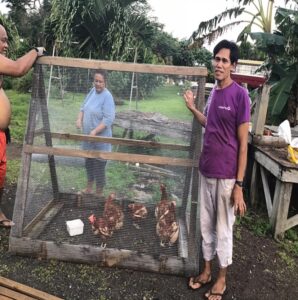
Vailoa Tanuvasa from Vailoa Village: Sagaia Lefee help set up his chicken tractor for his banana plantation
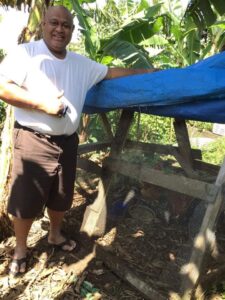
Here Tanuvasa visited Sagaia's chicken tractor project in Vaitogi
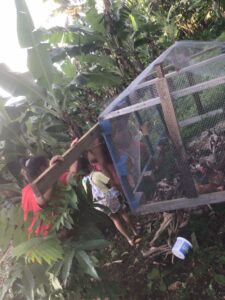
Chicken tractor moved. (Tanuvasa's banana plantation) Sagaia is with them helping them. She is doing a lot of extension work.
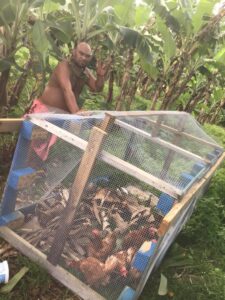
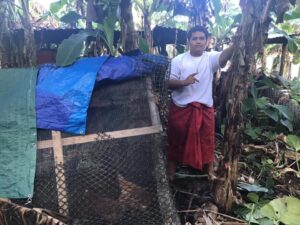
Boris Pualau Faleniu village: Totoa Curries agriculture student. He is picking up the chicken for his chicken tractor project for his banana plantation.
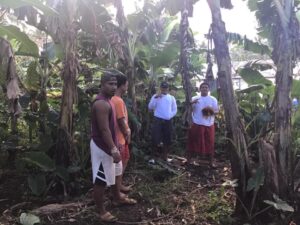
Boris and his brothers picking up chickens
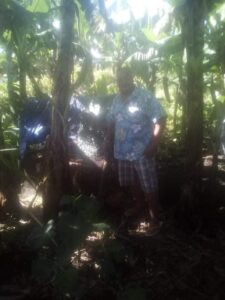
Lopati Lopeti from Alofa / Masefau Village: Read the brochure given to him by the principal of Iakina School in Iliili. He was so into the chicken tractor project that he left work and arrange with Sagaia to visited the chicken tractor project. Lopeti has many local chickens. He wants to raise them in cages. He changed his mind and copy the design for the chicken tractor project. He build tractor and have thin situation among his vegetables as well as his banana plantation.
Below is the picture of his wife
.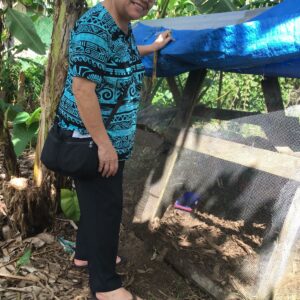
Mr. Lopeti's wife
Summary:
The project received funding approval in April 2018 with the goal of researching and demonstrating the potential and the value of including chickens in movable ‘tractors’ in the banana plantations.
We had certain research objectives besides the outreach efforts described above. Anecdotal information raised a concern that chickens could not be fed bananas. We proved that wrong. We often fed ripe bananas and also banana leaves to our chickens without any noticeable problems. The chickens would reach out and eat the young banana leaves whenever they could. We did need to react to the poor-quality feed provided through imported feeds. We supplemented our purchased feed with papaya fruit, ground coconut and leuceana leaves that are high in proteins and noticed quite a difference in the chickens and their egg production.
The effect of the chickens on the soil and the weed/ pest control has been described in the report text. The farmer is very satisfied with the vegetable production she is now seeing from the areas where the chickens were housed. The short-term vegetables such as tomato, eggplant, green onion, basil, hot and bell peppers are doing very well and the longer-term fruits such as papaya are now producing well with large fruit on healthy stems. This is in addition to the effect on the banana plants themselves.
We had proposed that there would be eggs to sell from this project to help the farmer’s income. In fact, the eggs produced were not as many as hoped but they did provide for the extended family needs so in a sense provided income. We figure this is due to the age of the chickens and the quality of the purchased feeds. At one point we lost all the chickens. We could not prove the cause. Another time we almost lost the next group because of mold in the purchased feed. We switched to ground coconut and local leaves. The chickens survived and improved but the egg production was reduced. We feel this is an important place for further research, to produce a good local feed supplement for chickens raised in this system. We also feel that more chicks should be either imported or hatched locally to provide a good supply of young birds for continuous production.
We thank Western SARE for the funding of this project and hope that our results meet the proposed expectations. Fa’afetai lava!
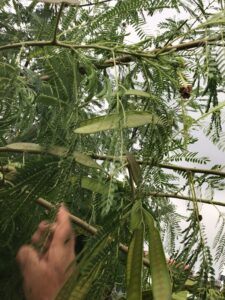
BUDGET
Sagaia Lefe’e CHICKEN TRACTOR PROJECT
Quantity Senior personnel
Field assistant
Salaries
UM 1
1 1
Item Each
Each Each
Description Farmer
Advisor
Farm assistant
Amount
3,640.00 + $759.75 +$1060.25=$5460 3,000.00 + 1060.25 + $2179.75 = $6240 1,750.00 + $700= $2,450
$14,150
|
Supplies |
|
40 chickens x $5.00: $200.00 |
First set of chickens were bought then as in the previous report with pictures of those chickens being brutally killed by someone. Ten more chickens were bought. Thought that was the end of that problem but it happened again so she bought five more chickens to replace the five that died. |
$200.00 |
|
Chickens |
40 chickens (split between two farmers) |
40 x $5.00 = $20-0.00 |
To help the two farmers to start their own chicken tractor Sagaia bought chickens to assist them |
$200.00 |
Materials for chicken tractor
Total chicken bought
4
1
1 1 1 1 1 1
10 4
10
Total materials
30
4 x 11.50
1 x 7.60: $7.60
1 x 16.76: $16.76 2 x 29.32: 1x120:
1 x 2,306:
1 x 10.20
75.00 each
10 x 8.95: 4 x 9.20
10 x 9.20 30 x 30.00
machetes hammers
Spade
Wheelbarrow Chipper shredder Gas cannister
2 inches mesh wire, 6 feet x 75 feet
Roofing
Lumber length 2x3x6
Lumber length
2 x 3 x 16
Pig feed to mix with coconut and other leaves feed to the
$400.00
$46.00 $24.36
$58.64 $120.00 $2,306.00 $10.20 $75.00
$89.50 $36.80
$92.00
$3,258.50
$900.00
Pig feed
|
chicken (after the initial phase of the project the farmer use her own funds to continue to do this.) |
|||
|
30 |
30 x 30 |
Sagaia bought extra pig feed for her chickens and given 4 bags of pig feed to help the farmers feed their chickens |
900.00 |
Total pig feed 1,800.00
|
Outreach (transportation to bring students over to the farm, food and refreshment) |
250 |
Allocation based on number of people @$2.00 per person |
Invited ASCC Land Grant, famers, friends of the farmer and students from two schools |
$200.00 |
|
300 allocated |
Allocation based on number of people @$2.00 per person 1. Visiting farmers 2. Assisting and setting up chicken tractors 3. Purchase chicken to start farmers chicken project on their property 4. Purchase pig feed |
People were invited on timely basis due to cov19. Following the rules and regulations given out by the government. |
$300.00 + $262.00 = $562.00 |
|
|
Total outreach |
$762.00 |
|||
|
Publications |
1 brochure 1 Newspaper article on Samoan news |
$500 allocated |
Copies were given out during the opening of the project, brochure shared to Land Grant, students in American Samoa, copies of the brochure were sent to Pohnpei, Australia, New Zealand, Western |
$500.00 |
|
Samoa. It was also published on facebook page (Sagaia,s page), Article was printed on Samoa News by Leua Aiono but she put it on Samoan language for farmers and older people. A rubric was created to evaluate the project by technical advisor and help farmer to stay focused on the project. |
||||
|
Brochure Published on Facebook |
$500.00 |
A lot of people call to understand the project. Some were interested others wanted to get free banana bunches or vegetable from the garden |
$500.00 |
|
|
Total publications |
$1,000.00 |
|||
|
Total amount allocated |
$19,231.00 |
|||
Total cost of $21,370.50 project
As indicated, the advisor and the farmer actually paid some of the cost of pig feed, extra chickens and outreach efforts from their own funds. That was our choice and no extra funds are expected.
Summary:
The project received funding approval in April 2018 with the goal of researching and demonstrating the potential and the value of including chickens in movable ‘tractors’ in the banana plantations.
We had certain research objectives besides the outreach efforts described above. Anecdotal information raised a concern that chickens could not be fed bananas. We proved that wrong. We often fed ripe bananas and also banana leaves to our chickens without any noticeable problems. The chickens would reach out and eat the young banana leaves whenever they could. We did need to react to the poor-quality feed provided through imported feeds. We supplemented our purchased feed with papaya fruit, ground coconut and leuceana leaves that are high in proteins and noticed quite a difference in the chickens and their egg production.
The effect of the chickens on the soil and the weed/ pest control has been described in the report text. The farmer is very satisfied with the vegetable production she is now seeing from the areas where the chickens were housed. The short-term vegetables such as tomato, eggplant, green onion, basil, hot and bell peppers are doing very well and the longer-term fruits such as papaya are now producing well with large fruit on healthy stems. This is in addition to the effect on the banana plants themselves.
We had proposed that there would be eggs to sell from this project to help the farmer’s income. In fact, the eggs produced were not as many as hoped but they did provide for the extended family needs so in a sense provided income. We figure this is due to the age of the chickens and the quality of the purchased feeds. At one point we lost all the chickens. We could not prove the cause. Another time we almost lost the next group because of mold in the purchased feed. We switched to ground coconut and local leaves. The chickens survived and improved but the egg production was reduced. We feel this is an important place for further research, to produce a good local feed supplement for chickens raised in this system. We also feel that more chicks should be either imported or hatched locally to provide a good supply of young birds for continuous production.
We thank Western SARE for the funding of this project and hope that our results meet the proposed expectations. Fa’afetai lava!
Research Outcomes
Education and Outreach
Participation Summary:
Project just beginning. No outreach activities completed to date
Sagaia Lefe’e :
Chicken Tractor Project used between banana project Progress Report
January 15, 2020
The last report that was send in has some materials were disturbing to us. Someone has been generous in killing the chicken in the project. Nonetheless, we had persevered and dealt with it. It did cause headache and finance that we could not afforded to spare but we did what we can to ensure the survival of the project.
First, Totoa Currie the technical advisor put together a rubric that helps us focused on what we were supposed to do. Please see the copy of the rubric attached to the report. Secondly, The field day. It was nice and I was worry because I never did public speaking. She (Totoa) coached me what to focus my discussion on. Director of Land Grant Mr. Aufa’I Areta, Dr. Ian Gurr and his assistance Ms. Emily came that day. You will see this on the brochure also. Student from Nuuuli Vocational Technical High School, Iakina school, farmers, family and friends attended the field day. Food and drinks were served to everyone. Totoa Currie and her husband were there also.
Director Aufai talks about the project and encourages to spread the news to neighborhood and farmers on the island. He challenges the students to think about majoring in agriculture once they graduate from high school. Dr. Gurr seems impressed with the project as well. They took pictures ask a few questions.
Sagaia has a Facebook page focusing on the project and the brochure is send out to anyone who has an email. A newspaper article was published concerning the project specifically on Samoan language this is to ensure that local people as well older people can read it on their own without needing any young one to read the English language.SARE Article Sagaia Lefe'e Chicken BrochureSagaia Lefee progress report 2019
Education and Outreach Outcomes
Information Products
- Chicken Tractor Brochure / Facebook (Article/Newsletter/Blog)